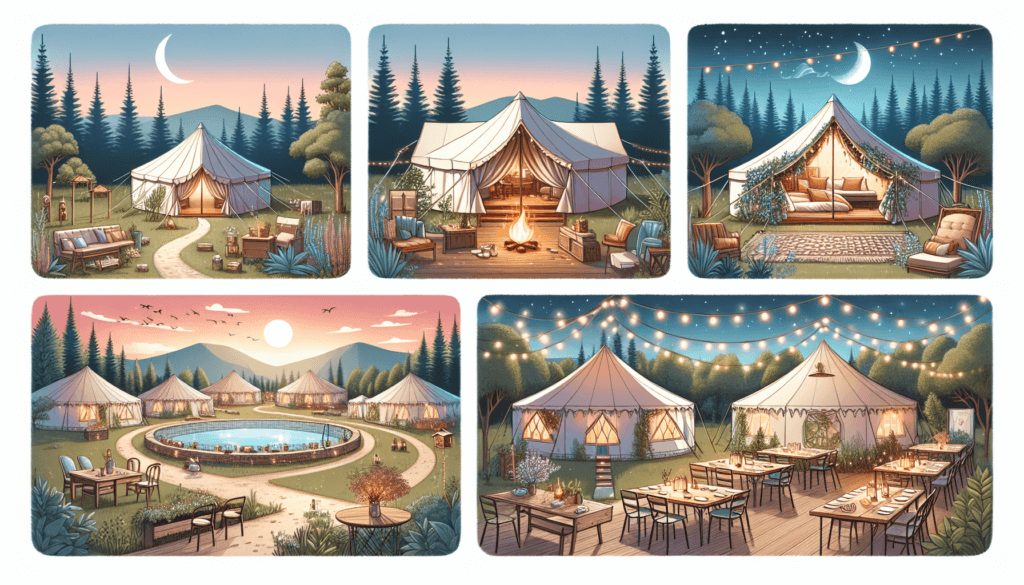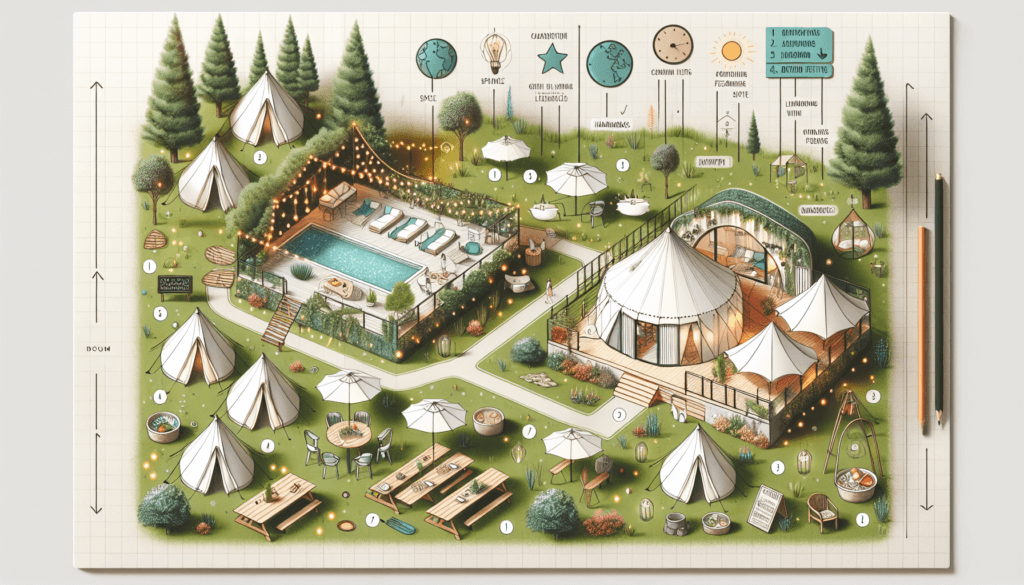Imagine immersing yourself in nature, surrounded by the tranquility of the great outdoors, while still enjoying the comforts of a cozy bed and fully equipped kitchen. This is the allure of glamping, a new trend that combines the joys of camping with the luxury of a hotel. In this beginner’s guide to setting up a glamping site, we will explore the essential steps to create your own oasis in the wilderness. Whether you’re an adventure enthusiast looking to start a new business venture or simply a nature lover in pursuit of a unique experience, this guide will provide you with all the tips and tricks you need to get started on your glamping journey.

Research and Planning
Choosing the Right Location
When setting up a glamping site, one of the first things you need to consider is the location. The right location can make or break your glamping business. Look for areas that offer picturesque natural landscapes, such as mountains, forests, or beaches. Consider proximity to tourist attractions and outdoor activities as well. Research the local regulations and restrictions to ensure that there are no limitations on setting up a glamping site in that particular area.
Determining Your Target Market
Before diving into the glamping business, it is crucial to identify your target market. Who are the people you want to attract to your site? Are you targeting adventure seekers, nature enthusiasts, families, or couples looking for a romantic getaway? Understanding your target market will help you tailor your glamping site to meet their specific needs and preferences.
Understanding Local Regulations
Every location has its own regulations and requirements when it comes to setting up a glamping site. Research and understand the local rules and regulations related to zoning, permits, and licenses. Make sure you comply with all legal requirements and obtain the necessary permits and licenses to avoid any potential legal issues in the future.
Examining the Competition
Take the time to conduct thorough research on existing glamping sites in your target area. Visit their websites and social media pages to gain insights into their offerings, amenities, and pricing. This research will help you understand what sets your glamping site apart from the competition and identify potential gaps in the market that you can leverage to attract customers.
Design and Infrastructure
Creating a Site Layout
Designing a well-planned site layout is essential for a successful glamping business. Consider factors such as the number and positioning of accommodation units, communal areas, parking facilities, and access to amenities. Creating a visually appealing and functional site layout will enhance the overall guest experience and maximize the use of the available space.
Choosing Accommodation Options
Glamping offers a unique and diverse range of accommodation options that go beyond traditional tents. Consider investing in unique structures such as yurts, safari tents, eco-pods, or treehouses. Each option offers a different experience for guests, allowing them to connect with nature while enjoying luxurious amenities.
Providing Amenities and Facilities
To create a comfortable and memorable experience for your guests, it is important to provide essential amenities and facilities. This includes bathrooms, showers, a communal kitchen or dining area, and outdoor seating areas. Additionally, consider offering amenities such as Wi-Fi, charging stations, and recreational activities to cater to the needs and desires of your target market.
Considering Sustainability
As glamping is closely connected to nature and the environment, adopting sustainable practices is highly recommended. Incorporate eco-friendly elements into your site design, such as solar panels, rainwater harvesting systems, and composting toilets. Use natural materials for construction and opt for energy-efficient appliances. By prioritizing sustainability, you not only contribute to the preservation of the environment but also appeal to eco-conscious travelers.

Legal and Financial Considerations
Registering and Licensing
Ensure that you register your glamping business and obtain the required licenses and permits. This may include registering as a business entity, obtaining a tourism license, and complying with health and safety regulations. Contact the local authorities or consult with legal professionals to ensure you meet all legal requirements.
Insurance and Liability
Protecting your glamping site and guests is crucial. Obtain comprehensive insurance coverage that includes liability protection for accidents or injuries that may occur on the premises. Consider insurance options specifically designed for glamping sites to cover potential damages to accommodations, equipment, and property.
Setting a Budget and Pricing
Creating a comprehensive budget is essential for the successful establishment and operation of your glamping site. Calculate the costs involved in land acquisition, site development, infrastructure setup, accommodation purchase or construction, and ongoing operational expenses. Research similar glamping sites in the area to determine appropriate pricing and ensure profitability while remaining competitive.
Financial Projections
It is recommended to create financial projections to assess the potential profitability of your glamping business. Take into account factors such as occupancy rates, average daily rates, operational costs, and marketing expenses. Financial projections will help you make informed decisions and develop strategies to achieve long-term financial sustainability.
Marketing and Branding
Defining Your Glamping Brand
Building a strong brand identity is crucial for attracting customers and differentiating yourself from the competition. Determine the unique selling points of your glamping site and create a brand that reflects the experience you offer. Consider factors such as the site’s location, accommodation options, amenities, and the target market’s preferences.
Developing a Marketing Strategy
A well-thought-out marketing strategy is key to promoting your glamping site effectively. Identify your target audience and develop marketing initiatives that will reach and resonate with them. Use a mix of online and offline marketing channels, such as social media marketing, email marketing, content creation, search engine optimization, and partnerships with local tourism boards or travel agencies.
Creating a User-Friendly Website
Your website will serve as the online face of your glamping site. It should be visually appealing, easy to navigate, and provide all the necessary information for potential guests. Showcase high-quality images of your accommodations, amenities, and the surrounding natural beauty. Incorporate an online booking system to streamline the reservation process and enhance the overall user experience.
Utilizing Social Media
Social media platforms are powerful tools for promoting your glamping site and engaging with potential guests. Create accounts on popular platforms such as Facebook, Instagram, and Twitter. Share captivating visual content, behind-the-scenes glimpses, guest testimonials, and information about upcoming promotions or events. Interact with followers, respond to comments, and use relevant hashtags to expand your reach.

Staffing and Operations
Hiring and Training Staff
Recruit and train a dedicated team of staff members who are passionate about delivering exceptional guest experiences. Staff should be knowledgeable about the local area, amenities, and activities. Provide thorough training on customer service, safety protocols, and maintaining cleanliness. Regularly assess staff performance to ensure high standards are maintained.
Managing Bookings and Reservations
Implement a reliable booking and reservation system to efficiently manage guest bookings. This system should provide real-time availability updates, secure payment processing, and an automated confirmation process. Regularly monitor bookings to ensure accurate availability and manage the distribution of accommodations effectively.
Ensuring Safety and Security
The safety and security of your guests should be a top priority. Conduct regular safety inspections, adhere to all relevant building codes, and provide clear instructions on emergency procedures. Install security measures such as lighting, surveillance cameras, and secure locks. Train staff on emergency response protocols, including first aid and evacuation procedures.
Maintaining Cleanliness and Hygiene
Maintaining cleanliness and hygiene is essential for guest satisfaction and maintaining a positive reputation. Implement thorough cleaning protocols for accommodations, bathrooms, and communal areas. Regularly inspect and restock essential supplies such as toiletries and cleaning products. Encourage feedback from guests to identify areas for improvement.
Guest Experience and Services
Providing Unique Experiences
One of the key attractions of glamping is the opportunity to provide unique experiences for guests. Offer activities such as guided nature walks, stargazing sessions, yoga classes, or cooking workshops using local ingredients. Collaborate with local tour operators or activity providers to offer a wide range of experiences that cater to different interests.
Offering Additional Services
Providing additional services can enhance the overall guest experience and set your glamping site apart from the competition. Offer services such as massage treatments, gourmet picnic baskets, or private chef services. Consider collaborating with local businesses to provide unique offerings that showcase the local culture, cuisine, or arts and crafts.
Creating a Welcoming Atmosphere
Creating a warm and welcoming atmosphere is crucial for guest satisfaction. Pay attention to details such as signage, lighting, and landscaping to create an inviting ambiance. Provide comfortable seating areas, cozy communal spaces, and outdoor fire pits where guests can gather and connect with each other.
Handling Guest Complaints
Even with the best efforts, there may be occasions where guests have complaints or concerns. It is essential to handle these situations professionally and promptly. Listen attentively to guests’ concerns, offer solutions or compensation when appropriate, and follow up to ensure their satisfaction. By resolving complaints effectively, you can turn dissatisfied guests into loyal advocates for your glamping site.

Reviews and Feedback
Encouraging Guest Reviews
Positive guest reviews can significantly impact the success of your glamping business. Encourage guests to leave reviews on platforms such as TripAdvisor, Google, or your website. Offer incentives such as discounts or small gifts for leaving reviews. Respond promptly and courteously to reviews, thanking guests for their feedback and addressing any concerns raised.
Monitoring and Responding to Feedback
Regularly monitor guest feedback across various online platforms. Address any negative feedback or concerns promptly and seek ways to rectify the issues. Respond to positive feedback as well, expressing gratitude and acknowledging the guest’s satisfaction. Use feedback as an opportunity for continuous improvement and to enhance the guest experience.
Implementing Improvements
Identify areas for improvement based on guest feedback and implement necessary changes. Whether it’s upgrading amenities, enhancing customer service training, or addressing maintenance issues, continuous improvement is key to staying ahead in the glamping industry. Regularly assess guest satisfaction through surveys or feedback forms to ensure ongoing enhancement of your offerings.
Building Customer Loyalty
Building strong relationships with your guests is essential for fostering customer loyalty. Offer loyalty programs or discounts for returning guests. Maintain an email list to communicate with guests and keep them informed about upcoming promotions or new offerings. Personalize communication whenever possible to make guests feel valued and appreciated.
Networking and Collaborations
Partnering with Local Businesses
Collaborating with local businesses can create mutually beneficial relationships. Partner with nearby restaurants, outdoor adventure companies, or local artisans to offer special packages or joint promotions. By cross-promoting each other, you can attract a larger audience and provide a more comprehensive experience for your guests.
Joining Glamping Associations
Consider joining glamping associations or organizations that can provide guidance, resources, and networking opportunities. These associations often offer educational programs, industry conferences, and access to a community of fellow glamping operators. By joining, you can stay up-to-date with industry trends and best practices, and forge valuable connections within the glamping community.
Attending Industry Events
Attending industry events and conferences can be highly beneficial for your glamping business. These events provide opportunities to learn from industry experts, gain insights into emerging trends, and network with suppliers and professionals in the field. Stay informed about upcoming events and make it a priority to attend those that are relevant to your business.
Building Relationships with Suppliers
Establishing strong relationships with suppliers is essential for ensuring the smooth operation of your glamping site. Collaborate with suppliers of accommodations, furniture, amenities, and any other products or services your site requires. Maintain clear communication, negotiate favorable terms, and establish a reliable supply chain that meets your site’s needs.

Maintenance and Upkeep
Regular Inspections and Maintenance
Regular inspections and maintenance are crucial for the longevity and safety of your glamping site. Conduct routine checks of accommodations, facilities, and grounds to identify and address any maintenance issues promptly. Have a maintenance checklist and schedule in place to ensure that all areas are inspected regularly.
Landscaping and Groundskeeping
Maintaining a well-manicured and visually appealing landscape is important for creating a welcoming environment. Regularly mow lawns, trim hedges, and weed flower beds. Consider incorporating local flora and fauna into the landscape to enhance the connection with nature. Maintain outdoor seating areas, paths, and lighting to ensure safety and functionality.
Maintaining Accommodation Units
Proper maintenance of accommodation units is essential for guest comfort and satisfaction. Create a maintenance schedule to inspect and clean each unit thoroughly between guests. Regularly check for structural issues, repair any damages, and ensure that all amenities and appliances are in working order. Pay attention to details such as bedding, linens, and decor to provide a fresh and inviting ambiance.
Updating and Upgrading
To stay competitive and meet evolving guest expectations, it is important to regularly update and upgrade your glamping site. Stay informed about industry trends and technological advancements. Consider guest feedback and reviews to identify areas that could benefit from upgrades or enhancements. Whether it’s introducing new amenities, improving energy efficiency, or upgrading technology, continuous updates ensure a memorable guest experience.
Expanding and Growing
Identifying Expansion Opportunities
Once your glamping site is well-established, you may consider expanding to capitalize on growing demand. Evaluate the feasibility of expanding the number of accommodations or adding new sites in different locations. Conduct market research to identify untapped customer segments or different types of accommodations that could attract a wider range of guests.
Adding New Accommodation Types
Diversifying your accommodation options can help attract new customers and cater to different preferences. Research emerging glamping trends and consider adding unique accommodation types such as geodesic domes, floating cabins, or converted vintage trailers. Each new addition should align with your brand identity and the overall experience you aim to provide.
Targeting Different Customer Segments
Targeting different customer segments can broaden your reach and appeal to a wider audience. Identify specific customer segments such as families, adventure enthusiasts, or luxury travelers, and tailor your offerings to cater to their unique needs and preferences. This may involve creating package deals, special promotions, or curated experiences for each segment.
Incorporating Eco-friendly Practices
As environmental consciousness continues to grow, incorporating eco-friendly practices can set your glamping site apart and attract environmentally conscious travelers. Consider utilizing renewable energy sources, implementing waste reduction and recycling programs, or sourcing local and organic products. Communicate your eco-friendly initiatives clearly to guests to showcase your commitment to sustainability.
Setting up a glamping site requires careful research, planning, and attention to detail. By considering factors such as location, target market, legal requirements, site design, marketing strategies, and guest experience, you can create a unique and successful glamping business. With a focus on providing exceptional experiences, maintaining high standards, and continuously adapting to industry trends, your glamping site can thrive and become a sought-after destination for travelers seeking a blend of nature and luxury.


